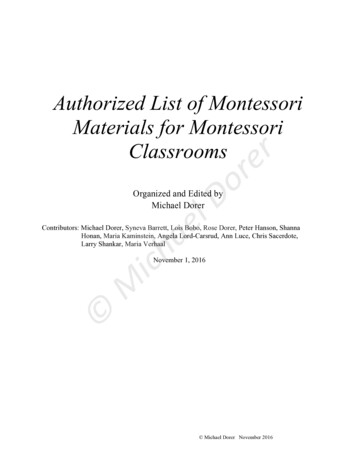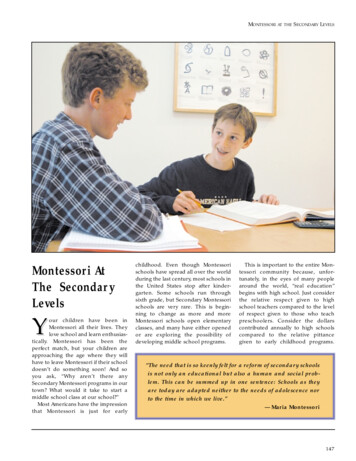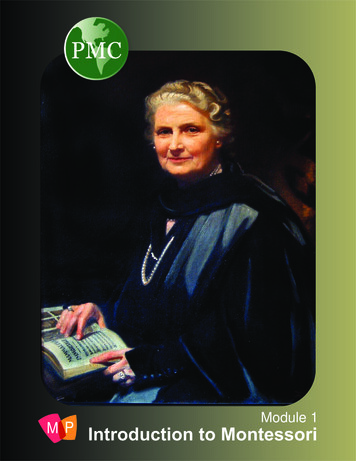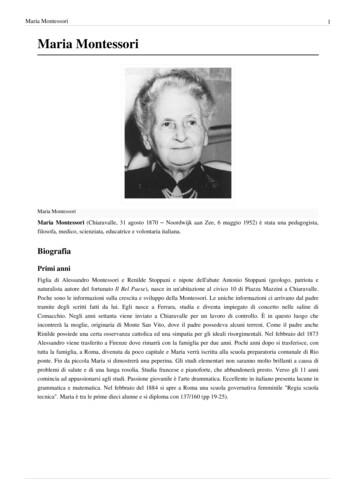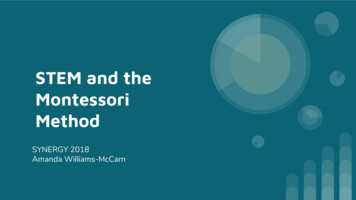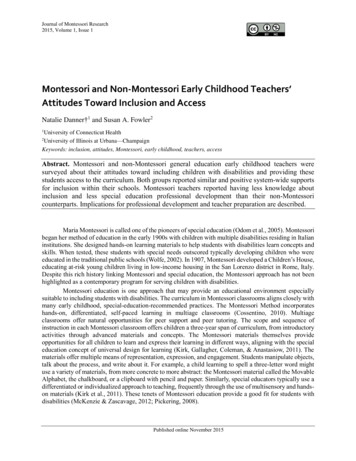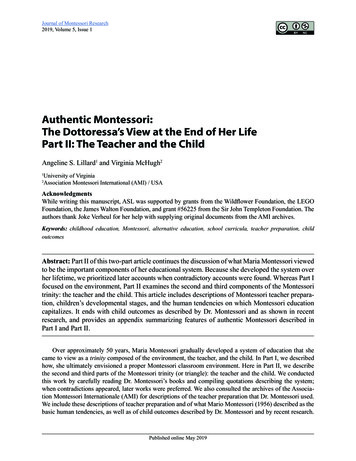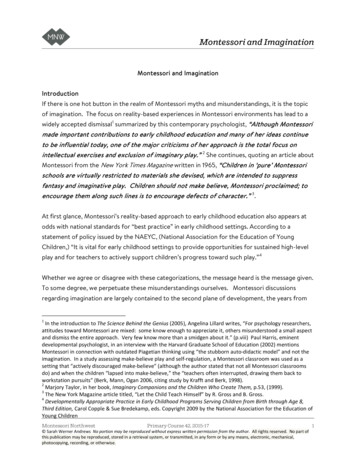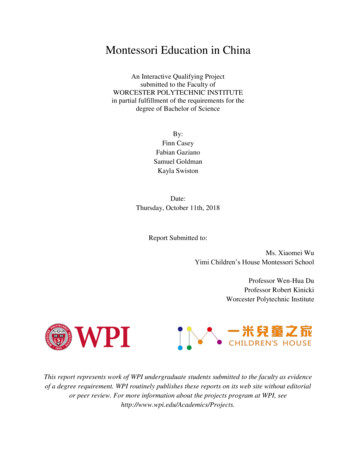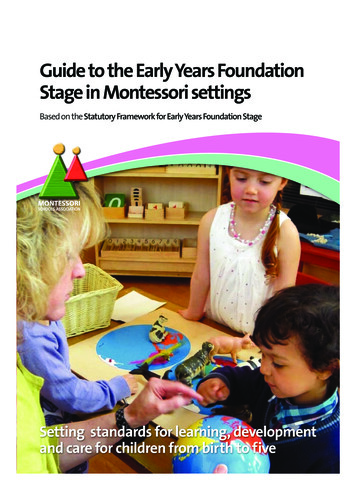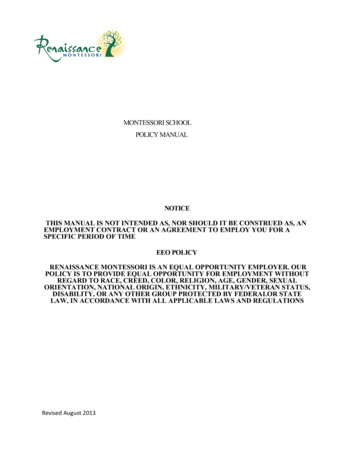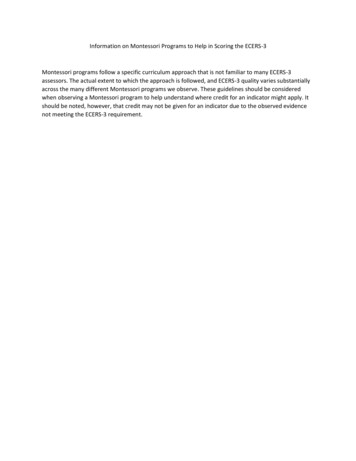
Transcription
Information on Montessori Programs to Help in Scoring the ECERS-3Montessori programs follow a specific curriculum approach that is not familiar to many ECERS-3assessors. The actual extent to which the approach is followed, and ECERS-3 quality varies substantiallyacross the many different Montessori programs we observe. These guidelines should be consideredwhen observing a Montessori program to help understand where credit for an indicator might apply. Itshould be noted, however, that credit may not be given for an indicator due to the observed evidencenot meeting the ECERS-3 requirement.
Montessori and the Early Childhood Environmental Rating ScaleA Crosswalk for Educators and AdvocatesAuthorsAnnie Frazer, M.Ed.Melanie Thiesse, M.Ed.Kathy Pratt, MAThis document was created through The Montessori Public Policy Initiative (MPPI), a collaborative effortbetween the American Montessori Society and the Association Montessori International/USA to provide acoordinated voice and engage in advocacy on policy issues affecting the future of Montessori schools inAmerica.Reprinted by permission of the Publisher. From Thelma Harms, Richard M. Clifford, and Debby Cryer, Early ChildhoodEnvironmental Rating Scale Third Edition (ECERS-3). New York: College Teachers Press. Copyright 2015 by Thelma Harms,Richard M. Clifford, and Debby Cryer. All rights reserved. ERS and Environmental Rating Scale are registered trademarks ofTeachers College, Columbia University.IntroductionThis document is a crosswalk between Montessori and the Early Childhood Environmental Rating Scale, ThirdEdition (ECERS-3) and is intended for use by Montessori schools in informing their classroom choices prior toobservation by an ECERS reliable rater so that they will have an understanding of how the rating scale isstructured and how the Montessori environment can be judged highly. It is also intended to assist advocacyrepresentatives in dialogues with state officials.Crosswalk: Montessori and the ECERS-3 MPPI 2018Page 1
Because the name Montessori is not trademarked, completeness of Montessori implementation varies widelybetween programs. This guide was created using the standards defined by the American Montessori Society(AMS) and the Association Montessori International/USA (AMI/USA) for a fully-implemented Montessoriclassroom.For a definition of Montessori education and further description of what to look for in a Montessorienvironment, please see MPPI’s Montessori Essentials document.MPPI Suggestions for ECERS-3 ItemsThe following chart highlights the specific ECERS-3 observation items where Montessori programs mayquestion how to meet the requirements specified. For each numbered item included from the ECERS-3,suggestions are given as to how the item requirement may be met in a Montessori environment. The observationitems not listed did not appear to have any conflicts that would affect Montessori classrooms.Space and Furnishings2. Furnishings for care, play and learningECERS-3MPPI SuggestionIndicator7.2Furniture designed for specific activities includes the dishwashing stand, puzzle map stand, dressingframe stand, bell cabinet, bead cabinet, art easel, book display shelf with covers facing out, etc.3. Room arrangement for play and learningECERS-3MPPI SuggestionIndicator3.2The Montessori classroom has defined areas where math, language, practical life, sensorial, and culturalmaterials are kept. However, children may take an activity from the shelf to use wherever in the roomthey are most comfortable. “Interest centers” may include areas for reading, dish- or cloth-washing, andother activities that benefit from specialized furniture.7.1The Montessori indoor environment is generally a quiet work space. As in a home, children learn toadjust the volume of their laughter and conversation to accommodate others’ needs. Still, there are areas,such as the Peace Table and book corner, where children can find an even quieter space if desired.4. Space for privacyECERS-3MPPI SuggestionIndicator5.1Children in a Montessori environment are explicitly taught to respect others’ work and not to interrupt. Achild’s work space, defined by a small table or a mat on the floor, is considered off-limits for otherchildren unless they have been invited to help.Crosswalk: Montessori and the ECERS-3 MPPI 2018Page 2
5. Child-related displayECERS-3MPPI SuggestionIndicator3.15.15.25.3A Montessori environment should be calm and restful to the eye, limiting distractions in order to supportconcentrated work. For this reason, posters, charts or graphs are seldom used.Objects of art and natural objects may be displayed as they would be in a home. Photos of children maybe displayed near each child’s cubby or coat hook.Because the Montessori environment is decorated like a home, the connection between displays andcurrent lessons may be subtle. Art works rotate throughout the year to expose the children to differentartists, styles of art, and time periods of art.Because Montessori classes emphasize process over product at the early childhood level, children’s workis not often displayed in the classroom unless initiated by the child.Personal Care Routines8. Meals/snacksECERS-3MPPI SuggestionIndicator3.3Snack in a Montessori classroom is available throughout the day to children as they are hungry. To ensuresanitary conditions during this flexible snack schedule, sanitized non-porous placemats labeled with thechildren’s names can be used.9. Toileting/diaperingECERS-3MPPI SuggestionIndicator5.2Montessori schools allow children to take an active role in the toileting process from a young age.Children may change their diapers or wet underwear with adult assistance while standing on a very lowchanging surface, a thin changing pad, or a designated area of the floor.Often, children who are being potty trained in a Montessori environment will wear training pants insteadof Pull-Ups or diapers. In the case of an accident, proper sanitary procedures are followed.11. Safety practicesECERS-3MPPI SuggestionIndicator5.2Not only are the staff responsible for child safety, but the children also take action to ensure everyone’ssafety and well-being. Children wipe up spills on the floor and table, close doors to the hallway, andnotify adults of situations which they are not taught to resolve (broken glass, for example). A teacher maybe aware of a spill, but if she sees that a child is taking care to clean it up, she will not interfere.Crosswalk: Montessori and the ECERS-3 MPPI 2018Page 3
Language and Literacy13. Encouraging children to use languageECERS-3MPPI SuggestionIndicator5.1Staff will not interrupt a child at work to ask questions. At other times, conversations with children mightinclude these kinds of questions: “What would you like to tell me about your picture? With whom did youwork today? What new things did you learn today?”14. Staff use of books with childrenECERS-3MPPI SuggestionIndicator7.1Current topics of study may not be immediately apparent, as the curriculum is not organized on the basisof rotating themes. Children often read books independently or with their friends or teachers that relate totheir current, individualized activities within the classroom.15. Encouraging children’s use of booksECERS-3MPPI SuggestionIndicator3.25.17.1Fantasy books are rarely used in a Montessori early childhood classroom. However, realistic fictionstories as well as factual books are accessible to the children.Reading is a choice for any child throughout the day. Rather than having books for all the children to readat the same time, a small selection of books is available all day. Books in the classroom are rotatedfrequently, piquing children’s interest and providing something new all the time to read.16. Becoming familiar with printECERS-3MPPI SuggestionIndicator7.17.4Montessori materials for literacy development are available on the shelves at all times. Because they arecontained in boxes with lids, they may not be immediately visible to the observer.In a Montessori classroom, picture/word instructions are not used for most classroom activities but maybe found at the snack table, in the cooking area, or in the garden.Learning Activities17. Fine motorECERS-3MPPI SuggestionIndicator5.17.2Although Montessori classrooms have a vast array of fine motor activities, they do not typically haveinterconnecting materials (Legos). Schools may have large interconnecting hollow blocks or anothersimilar activity on the playground.In a Montessori environment, all the shelves and containers are accessible to the children at all times.Rather than being labeled, the materials in each curriculum area are arranged in sequence from left toright and top to bottom, so that children know where to find each item and where to put it away. Schoolsmay color coordinate the trays of fine motor activities (practical life) to further encourage self-help.19. Music and movementECERS-3MPPI SuggestionIndicator5.1Music materials, including the Montessori bells and the listening center, are always available as a choiceCrosswalk: Montessori and the ECERS-3 MPPI 2018Page 4
5.25.37.27.3in the classroom. Children may use the bells independently throughout the day for matching, grading,composing, and reading music.Staff in a Montessori classroom set an example of quiet voice and calm body during “free play,” butfrequently sing and dance with children during circle time. The teacher may quietly sing a hand washing(or similar) song to a child during free play.Most Montessori environments have an ellipse marked on the floor for use with a variety of movementactivities. Children have lessons of increasing complexity about doing this work.Rhyming and sound games (which may or may not include songs) explore the awareness of sounds inwords. Children participate in these activities with adults and also with other children.20. BlocksECERS-3MPPI SuggestionIndicator1.13.1The Montessori sensorial materials include blocks such as the pink tower, broad stair, and knobbed andknobless cylinders. They are designed to teach concepts such as size, width, and length. In addition, eachset indirectly introduces the base 10 system with 10 blocks in each set. After initial introduction to theconcept, these materials may be combined in any number of ways by an individual or small group tocreate designs of their own imagination.Due to pedagogical differences, Montessori classrooms will not typically have block centers withaccessories available in the classroom.Credit may be given for blocks and accessories used outdoors, as long as gross motor time is met first.21. Dramatic playECERS-3MPPI SuggestionIndicator1.1Montessori classrooms do not typically have dramatic play centers in the classroom. The Montessoriclassroom provides children the opportunity to prepare and serve real food and use real brooms and mops,rather than pretend to do such things.Credit may be given for dramatic play areas and accessories used outdoors.22. Nature/scienceECERS-3MPPI SuggestionIndicator5.15.2Materials that meet this requirement include:Living things: plants, insects, petsNatural objects: shells, rocks, minerals, fossilsFactual books/nature-science picture games: books on the current topic of study, “parts of”puzzles and booklet making, living/non-living activity, three-part cardsTools: magnifying glass, compass, thermometer, magnetsSand or water with toys: land and water formsA Montessori teacher will respect a child who is focused and engaged in an activity by not interrupting totalk unnecessarily. Depending on the level of experience of the children, an observer may see a greater orlesser amount of adult involvement for this reason.Crosswalk: Montessori and the ECERS-3 MPPI 2018Page 5
23. Math materials and activitiesECERS-3MPPI SuggestionIndicator5.15.25.3Materials that meet this requirement include:Counting/comparing quantities Spindle box Sandpaper numerals and objects Bead chains Golden bead material Teen and tens boards Hundred boardMeasuring/comparing sizes Pink tower Brown stair Red rods Number rods Knobbed cylindersFamiliarity with shapes Geometric cabinet Geometric solids Metal insetsStaff or an experienced child will give initial lessons. Adults may join in to model certain skills; however,the goal is for a child or a group of children to be able to do the work independently. A Montessoriteacher will respect a child who is focused and engaged in an activity by not interrupting to talkunnecessarily. An observer may see a greater or lesser amount of adult involvement for this reason.Montessori teachers do not frequently use fingers to count, as it limits the child’s ability to matchnumbers and quantity to 10. However, a teacher may hold up fingers when singing a song with the classor reiterating a number outside of a math lesson.25. Understanding written numbersECERS-3MPPI SuggestionIndicator7.17.4This need is met with the following: Number Rods and Cards, Spindle Boxes, Teen Beads and Boards,Tens Beads and Boards, Gold Beads, the Stamp Game, and other materials.The observer will not see this practice during a lesson in math. However, a teacher may hold up fingerswhile reading a book or when referencing the appropriate number of scoops of snack, for example.26. Promoting acceptance of diversityECERS-3MPPI SuggestionIndicator5.15.25.3This item may be met with dramatic play materials for outdoor use.The Montessori curriculum is steeped in respect for diversity. Visible examples may include books,musical instruments, wall hangings, and items on the Peace Table; in addition, children take part incultural studies, try foods from other regions, and learn about the differences and similarities of peoplewith differing abilities.Crosswalk: Montessori and the ECERS-3 MPPI 2018Page 6
27. Appropriate use of technologyECERS-3MPPI SuggestionIndicatorAllMontessori classrooms support extensive development and refinement of the senses. As a result, there isvery little, if any, use of technology in Montessori early childhood communities.Interaction29. Individualized TeachingECERS-3MPPI SuggestionIndicator5.1Each of the materials in a Montessori environment has a clear purpose, and children are taught to use thematerials in particular ways. Within this structure, there are many opportunities for children to play withitems in open-ended ways. Examples are making up stories with small objects in the language area;creating unique structures with the block materials (brown stair, etc.); and painting at the easel.Program Structure34. Free playECERS-3MPPI SuggestionIndicator5.15.4A two- to three-hour, uninterrupted block of time for free choice is provided daily. Children may choosetheir own activities, ask for a lesson,, move freely between areas of the classroom, and work alone or in agroup. Free play outdoors is also part of a Montessori day.Children may work for as long as they like with a material they have chosen. If they want to use amaterial already in use, they choose a different activity until the material has been replaced on the shelf.Waiting for a desired material builds patience and strengthens social skills; at the same time, the presenceof many engaging activities allows children to easily find a second choice.Crosswalk: Montessori and the ECERS-3 MPPI 2018Page 7
ECERS-3 Requested Montessori Clarification ItemsSpace and Furnishings4. Space for privacy 5.1 - A child’s private space may be defined by a work rug on the floor if children areobserved respecting this private work space.Personal Care and Routines8. Meals/snacks3.3/5.3/7.1 - For self-served snack, sanitized, non-porous placemats labeled withchildren’s names may be used in lieu of sanitizing the table between children as longas no food is observed on the table itself.Language and Literacy15. Encouragementof use of books3.2 - Fantasy books include books that are fiction, even if they do not includefantastical beings or events.Learning Activities17. Fine motor5.1 - Outdoor interlocking material is acceptable as long as it is used during thethree-hour observation.20. Blocks1.1 - Use of combined Montessori blocks (pink tower, brown stair, red rods) meetsthis requirement even though all blocks are not more than 2 inches on most sides.Children must be able to combine the materials in their own way, creativelyconstructing.3.1 - Credit may be given for blocks and accessories used outdoors, as long as grossmotor time is met first.21. Dramatic play1.1 - Montessori classrooms will not typically have dramatic play centers in theclassroom. These materials may be found on the playground.Copyright Montessori Public Policy Initiative 2018
(AMS) and the Association Montessori International/USA (AMI/USA) for a fully-implemented Montessori classroom. For a definition of Montessori education and further description of what to look for in a Montessori environment, please see MPPI's Montessori Essentials document. M P P I S u gge s ti on s for E C E R S -3 I te ms
